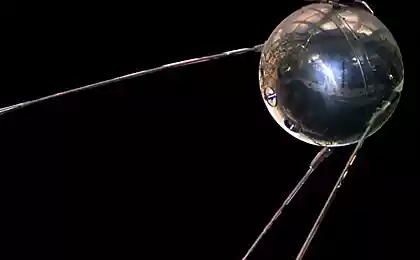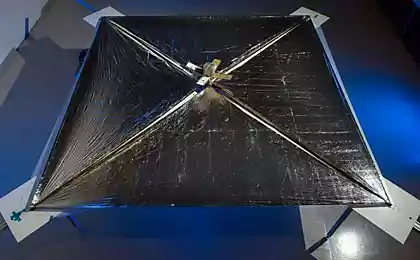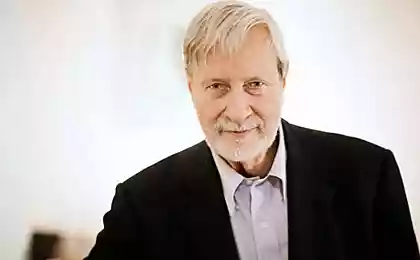1912
Satellite images - masterpieces of art
These images - the real satellite images of the Earth surface, created by the transfer of visible and infrared data to be printed in colors discernible to the human eye. To optimize these great shots were selected special combinations of bands and colors. Center data collection and processing systems of the Earth's resources in South Dakota has become the main receiving station for Landsat 7 satellite, which transmits data to other researchers around the world. Collected here are photos taken by Landsat 7 satellite, which had been selected rather because of their aesthetic than scientific value.


1. Icelandic tiger - Eija-Fjord, Iceland Icelandic This strip of the northern coast resembles the head of a tiger with stripes of orange, white and black. "Rot" tiger - a great Eija Fjord - deepest fjord, which stands between the mountains. The name translates as "Icelandic fjord," it came from the island Chrissi - a tiny island in the form of tears near the "mouth" of the tiger. Ice-free port of Akureyri is near the end of a narrow fjord and is the second largest center of population after the capital - Reykjavik. Picture taken Landsat 7 satellite on Oct. 21, 1999. (USGS / NASA)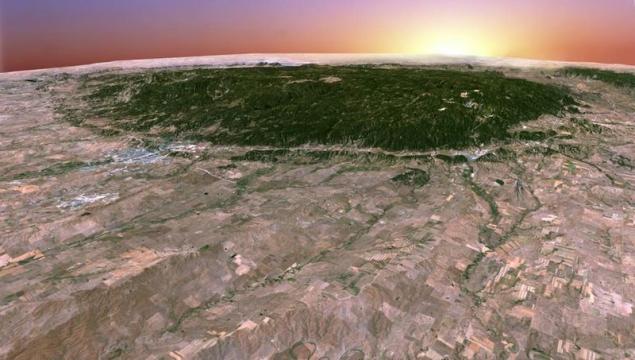
2. 3D Black Hills, South Dakota, USA Working student interns in the research and scientific center of the earth's resources, Mark Fersdal created this perspective Mountains Black Hills of South Dakota, connecting with four shots. (USGS / NASA / Mark Fersdal) 37,641,434
3. Bogda Mountains Turpan Basin, located in the foothills of Bogda is a strange mix of salt lakes and sand dunes and is one of the few places in the world that lies below sea level. Picture taken September 1, 1999. (USGS / NASA)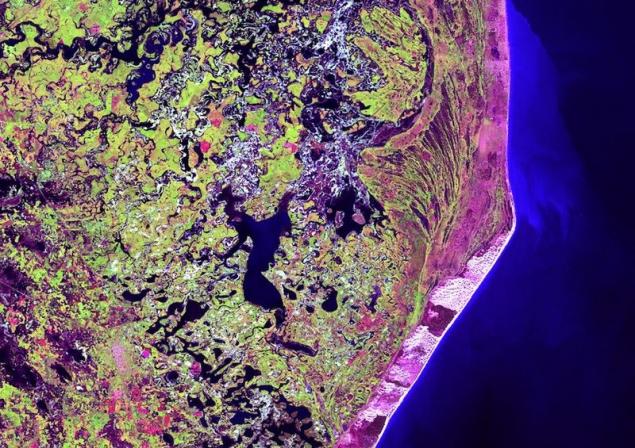
4. Cape San Antonio A few hundred kilometers to the southeast of Buenos Aires Cape San Antonio sticks out into the Atlantic Ocean along the Argentine coast. Picture taken November 21, 2002. (USGS / NASA)
5. Campeche Named after the ancient province Kimpech, Campeche is composed mainly of the western part of the Mexican Yucatan Peninsula. Rivers in southern Campeche Terminos fall into the lagoon, the entrance to which is protected by a long island of Isla del Carmen. Picture taken May 2, 2002. (USGS / NASA)
6. Snowy Volcano Colima Volcano of Colima - Mexico's most active volcano - stands out above the surrounding landscape in the state of Jalisco. Colima is a merger of two volcanoes - Nevado de Colima old in the north and the younger and more historically active volcano de Colima to the south. According to legend, the god sits on top of this volcano on a throne of ice and fire. Picture taken February 6, 2003. (USGS / NASA)
7. Delta Region, Netherlands Along the southern coast of the Netherlands with a cargo of river sediment have created a massive delta of islands and waterways in the crevices between the coastal dunes. After the unusually strong spring tides devastated the region in 1953, the Dutch built a system of dams, canals, dams, bridges and congestion, to curb the North Sea. Picture taken September 24, 2002. (USGS / NASA)
8. River Demin, Brazil Marshland River Demin in the north-western part of Brazil, which eventually flows into the Amazon. Picture taken March 15, 2000. (USGS / NASA)
9. Dull Green River Canyon in Utah flows through Tavaputs Plateau (top), and then enters the dull Canyon (center). Canyon cuts through the rocks and Rohan Beech - two long ladder-like ledge. As nearly as deep as the Grand Canyon, Dull Canyon is one of the largest unprotected places in the west of America. Picture taken December 31, 2000. (USGS / NASA)
10. The delta of the Ganges River Ganges River forms a vast delta where it empties into the Bay of Bengal. Delta is covered with marshy forests, known as Sanderbens in which he lives Royal Bengal Tiger. Picture taken 28 February 2000. (USGS / NASA)
11. River Negro, Brazil Fueled by numerous ponds and waterways, the river Negro is the largest tributary of the Amazon. Mosaic partially submerged islands usually disappears during the rainy season. Picture taken August 31, 2000. (USGS / NASA)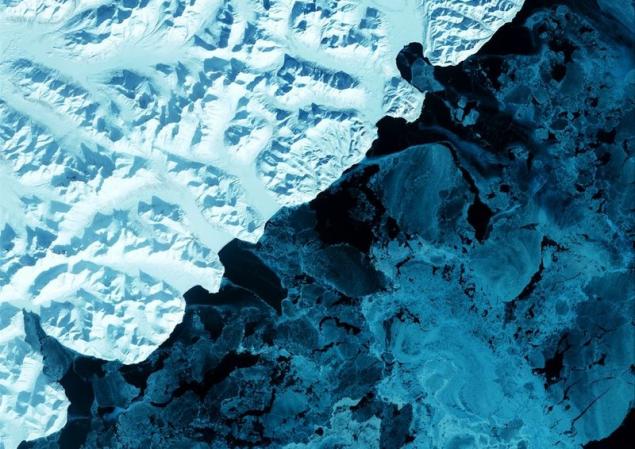
12. The Kamchatka Peninsula eastern side of Kamchatka peninsula sticks out into the Pacific Ocean to the west of Alaska. This volcanic area winter picture hidden under the snow-capped peaks and glaciers feed blue ice of the coastal waters. Picture taken February 17, 2002. (USGS / NASA)
13. Lake Disappointment Lake surrounded by sand dunes, Lake Disappointment Lake - is an annual salt lake in one of the most remote areas of Western Australia. An early explorer supposedly named the lake in 1987, when he thought that the numerous coves will lead him to the big lake. They led, but the salty water of the lake could not drink. Since then, the lake Lake Disappointment (from Eng. - Disappointing). Picture taken 21 December 2000. (USGS / NASA)
14. Glacier Malaspina Malaspina Glacier tongue - the largest in Alaska. Malaspina lies west of Yakutat Bay and stretches for 3,880 square kilometers Picture taken August 31, 2000. (USGS / NASA)
15 Namib Desert, Namibia National Park Namib-Naukluft National Park is an ecological reserve in the Namib Desert. Coastal winds create here the highest sand dunes in the world - some of them reaching 300 meters in height. Picture taken August 12, 2000. (USGS / NASA)
16. River Niger, Mali Massina Crossing the territory of Mali in West Africa, the Niger River is framed by the Sahara and then turns sharply to the south and joins the river Bani. At the confluence of two rivers delta formed with narrow winding lagoons, waterways and tiny islands. Picture taken February 8, 2003. (USGS / NASA)
17. Syrian desert fertile valley between the Euphrates River and farmland east coast of the Mediterranean Sea captures the Syrian desert of modern Syria, Jordan, Saudi Arabia and Iraq. Picture taken November 6, 2000. (USGS / NASA)
18. Oasis Terkezi series of rocky ledges of the landscape in the Sahara Desert near the oasis Terkezi in Chad. Picture taken October 22, 2000. (USGS / NASA)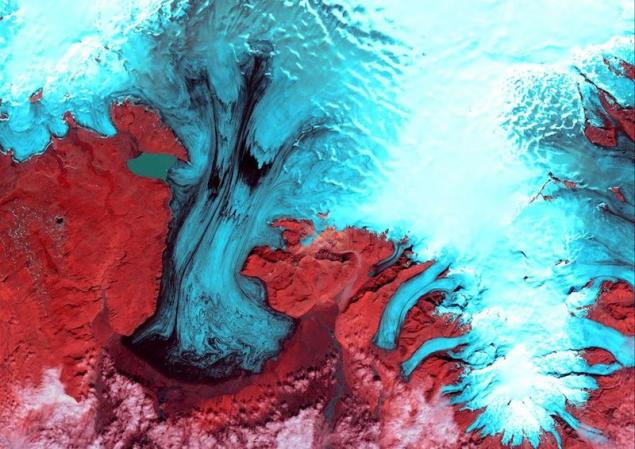
19. The glacier Vatnajökull These glaciers are similar to the fingers of blue ice, stretching from the glacier Vatnajökull in Skaftafell National Park in Iceland. The park lies at the southern end of the Vatnajökull. Picture taken August 4, 1999. (USGS / NASA)
20. Volcanoes, Chile - Argentina Cone tops of volcanoes along the border of Chile and Argentina added to the texture of the blue picture. From about 1800 volcanoes scattered throughout the area, 28 active. Photo of the Day February 1, 2002. (USGS / NASA)
21. Volga Delta Where the Volga flows into the Caspian Sea, formed a massive delta. It consists of more than 500 channels and supports most of the fish companies in Eurasia. Picture taken August 29, 2000. (USGS / NASA)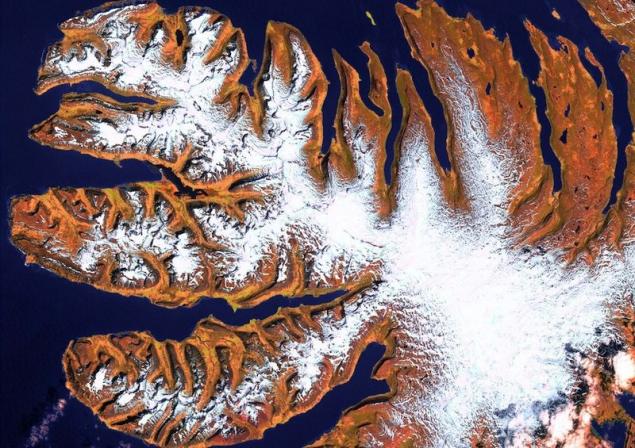
22. Western Fjords, Iceland Western Fjords - is a series of peninsulas in northwestern part of Iceland. They occupy less than one-eighth of the country, but their "ragged" perimeter accounts for more than half of the entire coastal area of Iceland. Picture taken June 6, 2000. (USGS / NASA)
via bigpicture


1. Icelandic tiger - Eija-Fjord, Iceland Icelandic This strip of the northern coast resembles the head of a tiger with stripes of orange, white and black. "Rot" tiger - a great Eija Fjord - deepest fjord, which stands between the mountains. The name translates as "Icelandic fjord," it came from the island Chrissi - a tiny island in the form of tears near the "mouth" of the tiger. Ice-free port of Akureyri is near the end of a narrow fjord and is the second largest center of population after the capital - Reykjavik. Picture taken Landsat 7 satellite on Oct. 21, 1999. (USGS / NASA)

2. 3D Black Hills, South Dakota, USA Working student interns in the research and scientific center of the earth's resources, Mark Fersdal created this perspective Mountains Black Hills of South Dakota, connecting with four shots. (USGS / NASA / Mark Fersdal) 37,641,434
3. Bogda Mountains Turpan Basin, located in the foothills of Bogda is a strange mix of salt lakes and sand dunes and is one of the few places in the world that lies below sea level. Picture taken September 1, 1999. (USGS / NASA)

4. Cape San Antonio A few hundred kilometers to the southeast of Buenos Aires Cape San Antonio sticks out into the Atlantic Ocean along the Argentine coast. Picture taken November 21, 2002. (USGS / NASA)

5. Campeche Named after the ancient province Kimpech, Campeche is composed mainly of the western part of the Mexican Yucatan Peninsula. Rivers in southern Campeche Terminos fall into the lagoon, the entrance to which is protected by a long island of Isla del Carmen. Picture taken May 2, 2002. (USGS / NASA)

6. Snowy Volcano Colima Volcano of Colima - Mexico's most active volcano - stands out above the surrounding landscape in the state of Jalisco. Colima is a merger of two volcanoes - Nevado de Colima old in the north and the younger and more historically active volcano de Colima to the south. According to legend, the god sits on top of this volcano on a throne of ice and fire. Picture taken February 6, 2003. (USGS / NASA)

7. Delta Region, Netherlands Along the southern coast of the Netherlands with a cargo of river sediment have created a massive delta of islands and waterways in the crevices between the coastal dunes. After the unusually strong spring tides devastated the region in 1953, the Dutch built a system of dams, canals, dams, bridges and congestion, to curb the North Sea. Picture taken September 24, 2002. (USGS / NASA)

8. River Demin, Brazil Marshland River Demin in the north-western part of Brazil, which eventually flows into the Amazon. Picture taken March 15, 2000. (USGS / NASA)

9. Dull Green River Canyon in Utah flows through Tavaputs Plateau (top), and then enters the dull Canyon (center). Canyon cuts through the rocks and Rohan Beech - two long ladder-like ledge. As nearly as deep as the Grand Canyon, Dull Canyon is one of the largest unprotected places in the west of America. Picture taken December 31, 2000. (USGS / NASA)

10. The delta of the Ganges River Ganges River forms a vast delta where it empties into the Bay of Bengal. Delta is covered with marshy forests, known as Sanderbens in which he lives Royal Bengal Tiger. Picture taken 28 February 2000. (USGS / NASA)

11. River Negro, Brazil Fueled by numerous ponds and waterways, the river Negro is the largest tributary of the Amazon. Mosaic partially submerged islands usually disappears during the rainy season. Picture taken August 31, 2000. (USGS / NASA)

12. The Kamchatka Peninsula eastern side of Kamchatka peninsula sticks out into the Pacific Ocean to the west of Alaska. This volcanic area winter picture hidden under the snow-capped peaks and glaciers feed blue ice of the coastal waters. Picture taken February 17, 2002. (USGS / NASA)

13. Lake Disappointment Lake surrounded by sand dunes, Lake Disappointment Lake - is an annual salt lake in one of the most remote areas of Western Australia. An early explorer supposedly named the lake in 1987, when he thought that the numerous coves will lead him to the big lake. They led, but the salty water of the lake could not drink. Since then, the lake Lake Disappointment (from Eng. - Disappointing). Picture taken 21 December 2000. (USGS / NASA)

14. Glacier Malaspina Malaspina Glacier tongue - the largest in Alaska. Malaspina lies west of Yakutat Bay and stretches for 3,880 square kilometers Picture taken August 31, 2000. (USGS / NASA)

15 Namib Desert, Namibia National Park Namib-Naukluft National Park is an ecological reserve in the Namib Desert. Coastal winds create here the highest sand dunes in the world - some of them reaching 300 meters in height. Picture taken August 12, 2000. (USGS / NASA)

16. River Niger, Mali Massina Crossing the territory of Mali in West Africa, the Niger River is framed by the Sahara and then turns sharply to the south and joins the river Bani. At the confluence of two rivers delta formed with narrow winding lagoons, waterways and tiny islands. Picture taken February 8, 2003. (USGS / NASA)

17. Syrian desert fertile valley between the Euphrates River and farmland east coast of the Mediterranean Sea captures the Syrian desert of modern Syria, Jordan, Saudi Arabia and Iraq. Picture taken November 6, 2000. (USGS / NASA)

18. Oasis Terkezi series of rocky ledges of the landscape in the Sahara Desert near the oasis Terkezi in Chad. Picture taken October 22, 2000. (USGS / NASA)

19. The glacier Vatnajökull These glaciers are similar to the fingers of blue ice, stretching from the glacier Vatnajökull in Skaftafell National Park in Iceland. The park lies at the southern end of the Vatnajökull. Picture taken August 4, 1999. (USGS / NASA)

20. Volcanoes, Chile - Argentina Cone tops of volcanoes along the border of Chile and Argentina added to the texture of the blue picture. From about 1800 volcanoes scattered throughout the area, 28 active. Photo of the Day February 1, 2002. (USGS / NASA)

21. Volga Delta Where the Volga flows into the Caspian Sea, formed a massive delta. It consists of more than 500 channels and supports most of the fish companies in Eurasia. Picture taken August 29, 2000. (USGS / NASA)

22. Western Fjords, Iceland Western Fjords - is a series of peninsulas in northwestern part of Iceland. They occupy less than one-eighth of the country, but their "ragged" perimeter accounts for more than half of the entire coastal area of Iceland. Picture taken June 6, 2000. (USGS / NASA)
via bigpicture

